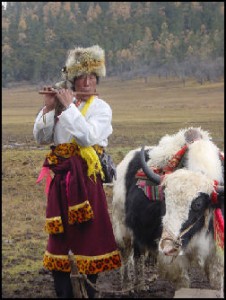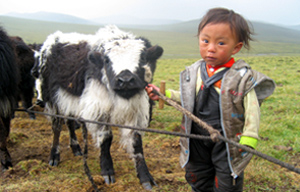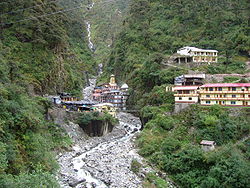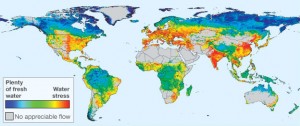Mountain Minorities and Indigenous Peoples

NGO Development Projects Active in Tibet
About ICIMOD – The International Centre for Integrated Mountain Development, ICIMOD, is a regional knowledge development and learning centre serving the eight regional member countries of the Hindu Kush-Himalayas – Afghanistan, Bangladesh, Bhutan, China, India, Myanmar, Nepal, and Pakistan – and based in Kathmandu, Nepal.
Globalisation and climate change have an increasing influence on the stability of fragile mountain ecosystems and the livelihoods of mountain people. ICIMOD aims to assist mountain people to understand these changes, adapt to them, and make the most of new opportunities, while addressing upstream-downstream issues. We support regional transboundary programmes through partnership with regional partner institutions, facilitate the exchange of experience, and serve as a regional knowledge hub. We strengthen networking among regional and global centres of excellence. Overall, we are working to develop an economically and environmentally sound mountain ecosystem to improve the living standards of mountain populations and to sustain vital ecosystem services for the billions of people living downstream – now, and for the future.
International Mountain Day, celebrated on December 11, gives us an opportunity to reflect on the relevance of mountains for the world. This year the International Mountain Day theme focuses on indigenous peoples and other minorities living in the mountains. The purpose is both to highlight the threats and challenges faced by these communities, and to acknowledge the invaluable knowledge they have and the contributions they can make towards overcoming global challenges of poverty and loss of diversity in a rapidly changing world.
A majority of the world’s indigenous women and men live in mountain regions, many on the margins of society and facing poverty and exclusion. The Hindu Kush-Himalayan region has some of the highest diversity of indigenous peoples and other minorities in the world. An ICIMOD report identified more than 600 living languages in the Himalayas, 400 spoken by less than 100,000 people. According to current forecasts, ninety per cent of all languages could disappear within 100 years. The loss of these languages not only erodes an essential component of a group’s identity, it is also a loss to heritage for all humankind.
The UN General Assembly adopted the UN Declaration on the Rights of Indigenous Peoples in September 2007, marking an important step in international efforts to preserve the identity of indigenous peoples. However, implementation has a different speed and different levels of commitment in different countries.
In agricultural terms, mountains are often considered ‘marginal lands’, unsuitable for modern commercial farming which focuses on cultivation of single crop varieties for large markets. Indigenous mountain people and other mountain communities continue to use traditional practices and techniques including sophisticated terracing systems, water transportation and irrigation schemes, and a combination of pasture, forestry and farming practices. Indigenous women and men serve as custodians of this traditional knowledge on how to farm under difficult mountain conditions, and how to conserve important reservoirs of agricultural biodiversity.
They sustainably farm a wide variety of crops that are adapted to a range of different elevations, slope conditions, and micro-climates, and this knowledge will be of great, if as yet little noticed, value in the world’s efforts to adapt to climate and other drivers of change. The autonomous adaptation practiced by mountain communities consists of community-based interventions that address underlying causes of vulnerability and reduce the risk of possible adverse impacts of climate change by building upon the existing rich indigenous knowledge base on adaptation to environmental change and helping to strengthen the resilience of the communities. Women especially play a critical role in gendered indigenous knowledge. Their roles and expertise have yet to be acknowledged, but has great potential for adapting to multiple drivers of change.
Indigenous mountain communities are connected to the land, the environment, and natural resources in ways that are often inextricably intertwined and therefore expressed in spiritual and socio-cultural terms. Respecting this worldview, and preserving the languages, music, artwork, folk tales, culture, meanings, and myths that express it, is critical for the survival of indigenous communities in mountain areas. This ‘intangible heritage’ also enriches the global community, providing inspiration and insights for realising a more sustainable relationship between humankind and the environment.
A scene from Tibetan Documentary „Leaving Fear Behind,“ shows a nomad school in Tibet (Amdo) working to preserve Tibetan Language and culture as it’s very existence is under threat from Chinese Government policies. Find out more: http://studentsforafreetibet.org Leaving Fear Behind: The Film the Chinese Government Doesn’t Want the World to See. // sumit sadhak practicing handstand in himalyas on the bank of ganga river one of the most important places for yogis.
The involvement of indigenous mountain communities is an important prerequisite for sustainable mountain development. Therefore, as governments work toward addressing mountain development priorities, it is critical that they live up to their commitments outlined in the UN Declaration on the Rights of Indigenous Peoples.
We hope that this year’s International Mountain Day will help to increase awareness of the central role of Minorities and Indigenous Peoples for mountain development, and to motivate all citizens, policy makers, and development actors to recognise the importance of their contribution to sustainable development. We trust that the Day will encourage organisations to invite indigenous and traditional mountain communities to participate actively in national and international efforts to understand and adapt to the multiple drivers of change, including climate change, in the mountains of the world.
With best wishes, Andreas Schild http://www.icimod.org
Culture and Development – Placing culture at the heart of development policy constitutes an essential investment in the world’s future and a pre-condition to successful globalization processes that take into account the principles of cultural diversity. It is UNESCO’s mission to remind all States of this major issue.
As demonstrated by the failure of certain projects underway since the 1970s, development is not synonymous with economic growth alone. It is a means to achieve a more satisfactory intellectual, emotional, moral and spiritual existence. As such, development is inseparable from culture. Strengthening the contribution of culture to sustainable development is a goal that was launched in connection with the World Decade for Cultural Development (1988-1998). Ever since, progress has been made thanks to a corpus of standard-setting instruments and demonstration tools such as cultural statistics, inventories, regional and national mapping of cultural resources.
In this regard, the major challenge is to convince political decision-makers and local, national and international social actors to integrating the principles of cultural diversity and the values of cultural pluralism into all public policies, mechanisms and practices, particularly through public/private partnerships.
This strategy will aim, on the one hand, at incorporating culture into all development policies, be they related to education, science, communication, health, environment or tourism and, on the other hand, at supporting the development of the cultural sector through creative industries. By contributing in this way to poverty alleviation, culture offers important benefits in terms of social cohesion. Read more: http://portal.unesco.org/culture/en
The Challenge of Human Rights and Cultural Diversity – United Nations Background Note by Diana Ayton-Shenker:
The end of the cold war has created a series of tentative attempts to define „a new world order“. So far, the only certainty is that the international community has entered a period of tremendous global transition that, at least for the time being, has created more social problems than solutions.
The end of super-power rivalry, and the growing North/South disparity in wealth and access to resources, coincide with an alarming increase in violence, poverty and unemployment, homelessness, displaced persons and the erosion of environmental stability. The world has also witnessed one of the most severe global economic recessions since the Great Depression of the 1930s.
At the same time, previously isolated peoples are being brought together voluntarily and involuntarily by the increasing integration of markets, the emergence of new regional political alliances, and remarkable advances in telecommunications, biotechnology and transportation that have prompted unprecedented demographic shifts.
The resulting confluence of peoples and cultures is an increasingly global, multicultural world brimming with tension, confusion and conflict in the process of its adjustment to pluralism. There is an understandable urge to return to old conventions, traditional cultures, fundamental values, and the familiar, seemingly secure, sense of one’s identity. Without a secure sense of identity amidst the turmoil of transition, people may resort to isolationism, ethnocentricism and intolerance.
This climate of change and acute vulnerability raises new challenges to our ongoing pursuit of universal human rights. How can human rights be reconciled with the clash of cultures that has come to characterize our time? Cultural background is one of the primary sources of identity. It is the source for a great deal of self-definition, expression, and sense of group belonging. As cultures interact and intermix, cultural identities change. This process can be enriching, but disorienting. The current insecurity of cultural identity reflects fundamental changes in how we define and express who we are today. Read More: * HERE*

www.business-humanrights.org , www.minesandcommunities.org
- Meet Students for a Free Tibet, studies, friends, fans at fb <
- Meet International Rivers, studies, friends, fans at fb <
- Meet The International Ecotourism Society (TIES) at fb <

Tibetan Nomads – Nomadic herders are known as drokpa. They make up about 25 percent of Tibetans in Tibet. In some Tibetan counties they make up 90 percent of the population. Herding families tend to be very poor, with a family typically getting by on an income of between $100 and $300 a year. Money is earned by trading animals for grain or selling them or their meat for money. Some traders and pilgrims are regarded as nomads.
There are an estimated 2 million Tibetans in the Tibet Autonomous Region and other Tibetan areas that practice some form of nomadism. For centuries these nomads have ranged across the grasslands of the Tibetan plateau with their grazing herds of sheep, cattle, goats and yaks.
Many of the inhabitants of the highland plateau are nomadic shepherds and yak and horse breeders. Southern Tibet—where the climate is less hostile and where there are a number of valleys where barley and other crops are raised— is main agricultural area and where most Tibetans in Tibet live. Most of the Tibetans that live there are farmers. Farmers and herders have traditionally exchanged products at annual and biennial markets, fairs and horse festivals. Herders in remote areas usually make grain-getting expeditions in the fall.
About half a million Tibetan nomads live on the Chang Tang, a huge, remote, 15,000-foot plateau rimmed by mountains. Tens of thousands of other Tibetan nomads can be found in other remote regions of Tibet. The nomads in the Phala region of the Chang Tang live in small camps consisting of two to eight tents. They herd yaks, sheep and horses, and reside throughout the year at sites ranging from 16,000 to 17,500 feet, which makes them the highest known resident native population in the world.
Most herders and nomads live in Nagqu prefecture—a 4,500-meter-high, 446,000 square kilometer region on the Qinghai-Tibetan plateau that accounts for 37 percent of Tibet Autonomous Region. Nagqu has the largest pastoral area and the highest productivity in the region. Breeding livestock accounts for 70 percent of the prefecture’s income and more than 90 percent of Nagqu residents make their living from it. Nagqu accounts for one third of the Tibet Autonomous Region’s animal husbandry.
Tibetan nomads have a lot in common with Mongolian nomads.
http://en.wikipedia.org/wiki/Category:Mines_in_Mongolia
A Nomad’s Life – Documentary Tibet & USA | Directed & Produced by Lynn True & Nelson Walker, Co-Produced by Tsering Perlo & Keefe Murren, Winner of the Sustaining Traditions Award, Supported by Green Mountain Coffee Roasters Foundation

A Nomads Life is a feature-length documentary about a young nomadic family, filmed in the high grasslands of Zachukha County, eastern Tibet. A young Tibetan family questions whether their nomadic traditions can survive against the challenges of a rapidly modernizing world.
Read More & about Tibetan Nomad and Chinas Resettlement Program:
http://factsanddetails.com/china
Human Rights Watch – Involuntary Resettlement Programs: The growing scale of forced resettlement projects across China to make way for infrastructure, environmental, and urbanization projects in 2007 continued to be marked by widespread irregularities, including lack of consultation, forced evictions, embezzlement, and corruption. China announced in October plans to relocate up to 4 million more people from areas surrounding the Three Gorges Dam-the world’s biggest hydroelectric power project.
Multiple programs to remove indigenous populations from environmentally fragile areas, such as on the Tibetan plateau, appear to be motivated, at least in part, by an integrationist agenda aimed at weakening minority cultural distinctiveness and extending Chinese control over their lives.
An official policy of forcibly relocating ethnic Tibetan herders in Tibet, Gansu, Qinghai and Sichuan to urban areas is seriously disrupting traditional lifestyles and has put under threat the livelihoods of approximately 700,000 such people already resettled. In September the Chinese government announced that it would resettle another 100,000 nomads from Qinghai province alone.
Read More: http://www.hrw.org/en/world-report-2008/china^
TIBETAN YOGA CENTER – AWAM FOUNDATION -In an effort to make the orphanage and elder center more sustainable, Rinpoche and his students developed a project aimed at providing long-term food contribution to the orphanage through an orphanage-owned yak farm. The Dharma Tara Yak Farm is managed free of charge by a local businessman in Tibet and is providing the orphans and elders with dairy products – the main part of diet in Tibet. Yaks purchased for the orphanage and elder center will never be killed for meat. Between 50-70 yaks are needed to provide for the 180 orphans and elders. Any excess dairy products will be in the future sold for purchase of other food articles for the orphanage. Khenchen Rinpoche is very hopeful about this project because it will provide for the orphans and elders as well as help sustain the traditional way of care for yaks. With recent changes in Tibet, increasing numbers of yaks are being raised for meat and slaughtered in a cruel way.
Yak Farm http://www.awamfoundation.org/yakfarm.html
Tibetan Yoga Center http://www.deinayurveda.net/wordpress/?p=13139
When the Ice melts in Tibet –Tibetan nomads could be brought back to act as stewards of Tibet’s grasslands Keeping Tibet’s rivers in pristine free-flowing condition will be a challenge over the next decade. The highest percentage of water for these rivers comes from glaciers. Working against the rivers are rapid glacial meltdown and environmental degradation. Some experts believe that 75 percent of all Himalayan glaciers less than 15 square kilometres in size will simply vanish within the next three decades.
http://www.meltdownintibet.com/f_solutions.htm
Who Owns Yoga? Not Bikram! | elephant journal – So, who owns yoga? This has become a central question in the debate over the now multibillion-dollar yoga industry. Follow the money, follow yoga moguls like Bikram, and issues of ownership will not lag far behind.
http://www.elephantjournal.com/2010/12/who-owns-yoga-not-bikram/
Articles on Orgins of Yoga & Similarities of Buddhism Yoga:
http://www.deinayurveda.net/wordpress/?s=hatha+yoga
http://www.deinayurveda.net/wordpress/?s=bhakti+yoga
ASIA FAIR – Childwellness EU – Glacier Melting – Ecotourism:
http://www.deinayurveda.net/wordpress/?p=13158

The origins of the Chota Char Dham are obscure. Originally, the appellation Char Dham referred to a pilgrimage circuit encompassing four important temples—Puri, Rameshwaram, Dwarka, and Badrinath—located roughly at the four cardinal points of the subcontinent. An archetypal All-India pilgrimage circuit, the formation of the original Char Dham is credited to the great 8th century reformer and philosopher Shankaracharya (Adi Sankara)/Advaita Vedanta. At some point, Badrinath, the last visited and the most important of the four sites in the original Char Dham, also became the cornerstone of a Himalayan pilgrimage circuit, which was dubbed the Chota („Little“) Char Dham to avoid confusion.
In the original Char Dham, three of the four sites are Vaishnava (Puri, Dwarka and Badrinath) while one is Shaiva (Rameshwaram). The Chota Char Dham included representatives from all three major Hindu sectarian traditions (of Yoga), with two Shakta(goddess) sites, (Yamunotri and Gangotri), one Shaiva site (Kedarnath), and one Vaishnava site (Badrinath).
http://en.wikipedia.org/wiki/Chota_Char_Dham
Ritual duties are supervised by the Semwal family of pujaris. The aarti ceremony at the Gangotri is especially impressive, as is the temple, a stately affair that sits on the banks of the rushing Ganges. Adventurous pilgrims can make an overnight 18 km trek to Gaumukh, the actual current source of the river Ganges.
For a large number of tourists, Gangotri town serves as the starting point of the Gangotri-Gaumukh-Tapovan and Gangotri-Kedartal trekking routes.
http://en.wikipedia.org/wiki/Gangotri
Yamunotri temple is situated in the western region of Garhwal Himalayas at an altitude of 3,235 metres (10,614 ft) in Uttarkashi district, Uttarakhand. The temple is dedicated to Goddess Yamuna.
Lodging at the temple itself is limited to a few small ashrams and guest-houses. Ritual duties such as the making and distribution of prasad (sanctified offerings) and the supervision of pujas (ritual venerations) are performed by the Uniyal family of pujaris (priests). Unique aspects of ritual practice at the site include hot springs where raw rice is cooked and made into prasad.
http://en.wikipedia.org/wiki/Yamunotri

Water map shows billions at risk of ‚water insecurity‘ – About 80% of the world’s population lives in areas where the fresh water supply is not secure, according to a new global analysis. Researchers compiled a composite index of „water threats“ that includes issues such as scarcity and pollution. The most severe threat category encompasses 3.4 billion people.Writing in the journal Nature, they say that in western countries, conserving water for people through reservoirs and dams works for people, but not nature.They urge developing countries not to follow the same path. http://www.bbc.co.uk/news/science-environment-11435522
The Blue Circle – The Himalayas, A Special Report – With one-fifth of the world’s population relying on seasonal Himalayan melting, the disappearance of the Third Pole is sending warning signs.
Floods, droughts, wildfires, windstorms, water contamination and illnesses plague the 1.3 billion people who live in the watersheds directly supplied by glacial melt from the Hindu Kush-Himalaya (HKH) region.
The waterways of Afghanistan, Bangladesh, Bhutan, China, India, Myanmar, Nepal, and Pakistan are endangered, and scientists are gaining a bettter understanding of just how fast climate change is taking its toll on the region.
As the Himalayan glaciers disappear, ten major Asian river systems–the Amu Darya, Indus, Ganges, Brahmaputra, Irrawaddy, Salween, Mekong, Yangtse, Yellow, and Tarim–are threatened. Twenty percent of the world’s population faces a future of catastrophe, according to a report released by University College, Chinadialogue, and King’s College of London in May 2010.
Extreme glacial melt, seismic activity and extreme weather events are already affecting the region’s rivers, lakes, wetlands and coasts. The devastation is a warning sign of what’s to come.
In these feature articles, news briefs, photographs, and graphics Circle of Blue documents one of the critical front lines in the global battle against climate change and water scarcity.
In these feature articles, news briefs, photographs, and graphics Circle of Blue documents one of the critical front lines in the global battle against climate change and water scarcity.
http://www.circleofblue.org/waternews/himalayas
http://www.chinadialogue.net/UserFiles/File/third_pole_full_report.pdf

Groundwater Depletion Raises Likelihood of Global Food Crises
Food Security (Human Right), Milleniumgoals and Nagoya treaty, Biodiversity, Sustainable Agriculture, Carbon Footprint, Climate Change, etc:
The volume of fresh water pouring from the world’s rivers has risen rapidly since 1994, researchers say is further evidence of global warming. The study, led by a team at UC Irvine, is the first to estimate global fresh-water flow into the world’s oceans using observations from new satellite technology rather than through computer or hydrological models.
http://latimesblogs.latimes.com/greenspace/2010/10/global-warming-river-flows-oceans-climate-disruption.html
Arctic Ocean Freshwater (greatest Reservoir beneath Glaciers) Changes Over the Past 100 Years
http://soa.arcus.org/abstracts/arctic-ocean-freshwater-changes-over-past-100-years-and-their-causes
The freshwater budget of the Arctic Ocean Von E. Peter Jones, North Atlantic Treaty Organization. Scientific Affairs Division: Oceanic Response: *HERE *
A change in the freshwater balance of the Atlantic Ocean (Gulf Stream Impact ?)
http://www.nature.com/nature/journal/v426/n6968/full/nature02206.html
Economic, social and cultural rights for all
Comments are closed.
